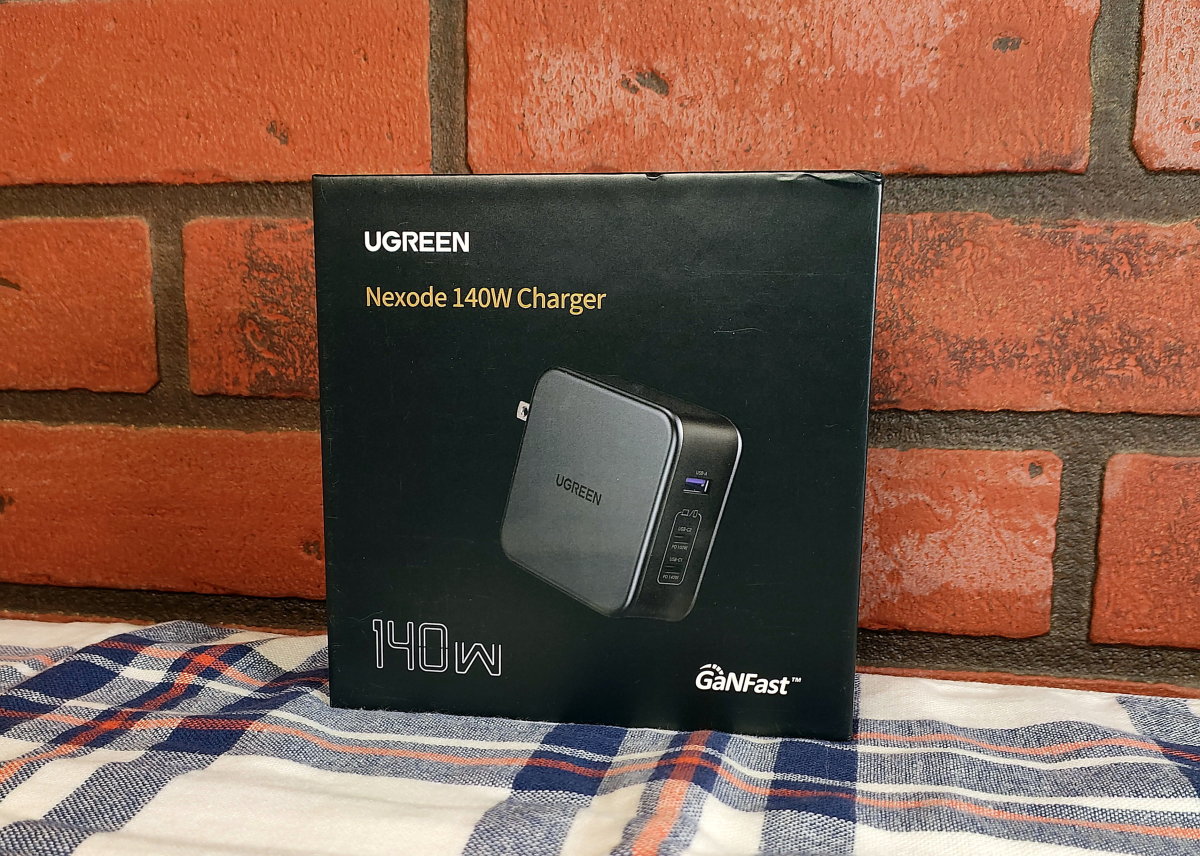Walter Shillington In this article, I will be examining the Ugreen Nexode 140W charger. It is an excellent example of the new wave of devices capable of handling the charging requirement of everything from an electric toothbrush to a MacBook Pro.
Description
The Ugreen Nexode 140W charger is 3 inches high, 1.4 inches wide, and 3 inches thick. It weighs 10.5 ounces. The charger’s case is composed of gray plastic with two front-mounted USB-C ports and one USB-A port. A pair of prongs at the device’s rear may be unfolded and plugged into an AC outlet. Walter Shillington While the lower USB-C port can supply up to 140 watts, the available power is shared if other ports are connected to devices. Due to its high-capacity output, this charger is ideal for those with MacBooks and other notebooks compatible with USB-C charging. And, because it is fitted with multiple ports, three devices may be charged simultaneously. The Ugreen Power Dispenser system intelligently adjusts power output, helping to protect the charging device’s battery. This system incorporates GaN technology and is compatible with a wide range of protocols utilized to charge batteries quickly. A six-foot USB-C to USB-C charging cable is provided in the package.
Specifications
Manufacturer: Ugreen Name: Nexode 140W Charger Model: CD289 Weight: 297 grams (10.5 ounces) Dimensions: 7.6 x 3.5 x 7.6 centimeters (3 x 1.4 x 3 inches) Input power: 100-240VAC 2.A 50-60Hz Output power: 140 watts (max) Outputs: 2 USB-C plus 1 USB-A Intelligent power allocation: Yes Technology: GaN USB-A port compatibility: SCP, QC3.0, AFC, FCP, APPLE 5V2.4A, BC1.2 supported (most devices) USB-C port compatibility: PD3.1(PD3.0\PD2.0), QC4+(QC4.0\QC3.0\QC2.0), PPS, AFC, APPLE 5V2.4A, BC1.2 enabled laptops, tablets, and phones
GaN Technology
Gallium nitride is a semiconductor material that rose to eminence in the 1990s. This crystal-like material boasts a broader bandgap than its silicon rival, allowing energy to pass through more efficiently. This results in higher power limits and lower operating temperatures. Walter Shillington Walter Shillington
Fast Charging Protocols
Power Delivery
The Power Delivery (PD) specification denotes higher power capabilities, allowing USB-C PD-enabled devices to charge quickly over a USB connection. The two coupled devices negotiate a power contract, determining how much power will be pulled from the charger.
QC3/4
Quick Charge is a battery charging protocol developed by Qualcomm which is used to manage USB-delivered power. Like with the Power Delivery protocol, the device negotiates with the power supply to determine the voltage provided.
FCP/SCP
Huawei developed these Fast Charge protocols.
Adaptive Fast Charging
The AFC protocol utilizes a system that begins charging at a high rate, allowing devices to be charged quickly to about 50 percent. Then the charging rate drops significantly to prevent overheating.
BC1.2
The Battery Charging 1.2 protocol is a USB3 extension that extends the charging limit from 0.9A to 1.5A.
APPLE 5V2.4A
This older protocol is still in use. It extends the charging limit to 2.4 amps at 5 volts.
Compatibility
Although the Nexode 140W can charge most devices, not all can take advantage of its fast-charging capabilities. Listed below is a partial list of devices using compatible fast charging protocols. This charger is compatible with MacBook Pro, MacBook Air, Dell XPS/Inspiron, HP Elite, Google Pixel-book, Microsoft Surface Book 2, and ThinkPad. It can also recharge a wide range of iPads. It is compatible with iPhone 13, Galaxy S22 Ultra, Note 20, Google Pixel 6, Sony XZ3, Sony Xperia 1, and many older versions of these phones. The Nexode 140W Charger also works with a variety of accessories such as Nintendo Switch, Apple Watch, Air Pods, and power banks.
Charging Multiple Devices
The USB-A port can output up to 22.5 watts. The upper USB-C can supply 100 watts, and the lower USB-C port provides up to 140 watts. The charger’s maximum power output is 140 watts. Because of this limit, the power available at each port drops as additional devices are connected. If, for example, MacBook Pro laptops were plugged into each USB-C port, they would draw 65 watts of power. If a device were plugged into the USB-A port as well, it would be supplied up to 22.5 watts of power, the top USB-C port could deliver 45 watts, and the bottom port could supply 65 watts of power.
Overall Impression
While this charger is outwardly small and uncluttered, it is incredibly sophisticated and adaptable to the demands of the connected devices. The charger’s maximum output of 140 watts and ability to intelligently allocate power ensures three devices can be efficiently charged simultaneously. Walter Shillington Walter Shillington This charger can handle the demands of notebooks, tablets, and phones that benefit from protocols such as Power Delivery and Qualcomm Quick Charge. This allows it to charge these devices faster than many competing chargers. The Ugreen Nexode 140W Charger is recommended. This content is accurate and true to the best of the author’s knowledge and is not meant to substitute for formal and individualized advice from a qualified professional. © 2022 Walter Shillington









